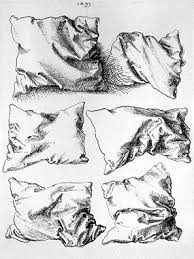Figurative Drawing
Thursday, December 8, 2011
Crosshatching
Cross-hatching is a method of line drawing that describes light and shadow. The representation of light utilizes the white or openness of the page, while shadow is created by a density of crossed lines. The erasing was necessary to achieve negative space that was efficient for the end product of the apple.
September 16: Capricho
Los Caprichos are a set of 80 aquatint prints created by the Spanish artist Francisco Jose de Goya in 1797 and 1798, and published as an album in 1799. The prints were an artistic experiment: a medium for Goya's condemnation of the universal follies and foolishness in the Spanish society in which he lived. The criticisms are far-ranging and acidic; he speaks against the predominance of superstition, the ignorance and inabilities of the various members of the ruling class, pedagogical short-comings, marital mistakes, and the decline of rationality. Some of the prints have anticlerical themes. Goya described the series as depicting "the innumerable foibles and follies to be found in any civilized society, and from the common prejudices and deceitful practices which custom, ignorance, or self-interest have made usual".[1]
The work was an enlightened, tour-de-force critique of 18th-century Spain, and humanity in general. The informal style, as well as the depiction of contemporary society found inCaprichos, makes them – and Goya himself – a precursor to the modernist movement almost a century later. The Sleep of Reason Produces Monsters in particular has attained an iconic status.
Goya added brief explanations of each image to a manuscript now in the Prado; these help greatly to explain his often cryptic intentions, as do the titles printed below each image.
Goya's series, and the last group of prints in his series The Disasters of War, which he called "caprichos enfáticos" ("emphatic caprices") are far from the spirit of light-hearted fantasy the term caprice usually suggests in art.

Tuesday, November 29, 2011
VOCAB Assignment: Ian Cameron, Sunstar Cove Bay, May 6 2008
foreground, middleground, background: The foreground, middleground, and background in a composition are generally divided into three planes. The foreground of a composition is the visual plane that appears closest to the viewer, while the background is the plane in a composition percieved furthest from the viewer. The middleground is the visual plane located between both the foreground and background. The scale of these components often correlates to the dominance in an image. The foreground is often the most dominant due to the larger percieved scale of the images objects. This is not always the case, however, as definition and other factors can shift the dominance of the composition.


VOCAB Assignment: (picture of canvas)
picture plane: A picture plane is the imaginary flat surface which is usually located between the station pointand the object being viewed and is ordinarily a vertical plane perpendicular to the horizontal projection of the line of sight to the object's order of interest.
In painting the picture plane refers to the flat surface of the canvas or the physical material onto which the paint is applied. It generally refers to the front of the surface image, especially in the case of illusionary depth, although it can also refer to the picture's ground. The illusion of depth and three dimensionality that accompanies certain types of pictures is described as penetrating the picture plane.
VOCAB Assignment: Andy Warhol, Banana, 1966
postmodernism: Postmodernism is a philosophical movement evolved in reaction to modernism, the tendency in contemporary culture to accept only objective truth and to be inherently suspicious towards a global cultural narrative or meta-narrative. Postmodernist thought is an intentional departure from the previously dominant modernist approaches. The term "postmodernism" comes from its critique of the "modernist" scientific mentality of objectivity and the progress associated with the Enlightenment. Modernism and postmodernism are understood as a cultural stance or set of perspectives. "Postmodernism" is used in critical theory to refer to a point of departure for works of literature, drama, architecture, cinema, journalism, and design. It has also influenced marketing, business and the interpretation of law, culture, and religion in the late 20th and early 21st centuries. Postmodernism, particularly as an academic movement, can be understood as a reaction to modernism in the Humanities. Whereas modernism was primarily concerned with principles such as identity, unity, authority, and certainty, postmodernism is often associated with difference, plurality, textuality, and skepticism.

VOCAB Assignment: Hans Hofmann, The Gate, 1959-1960
modernism: Modernism, in its broadest definition, is modern thought, character, or practice. More specifically, the term describes the modernist movement, its set of cultural tendencies and array of associated cultural movements, originally arising from wide-scale and far-reaching changes toWestern society in the late 19th and early 20th centuries. The modernist movement, at the beginning of the 20th century, marked the first time that the term "avant-garde", with which the movement was labeled until the word "modernism" prevailed, was used for the arts (rather than in its original military and political context). Surrealism gained fame among the public as being the most extreme form of modernism, or "the avant-garde of modernism"


VOCAB Assignment: Albrecht Durer, Six Pillows, 1493
crosshatching: Crosshatching is an extension of hatching, which uses is the use of fine parallel lines drawn closely together, to create the illusion of shade or texture in a drawing.

Crosshatching is the drawing of two layers of hatching at right-angles to create a mesh-like pattern. Multiple layers in varying directions can be used to create textures. Crosshatching is often used to create tonal effects, by varying the spacing of lines or by adding additional layers of lines. Crosshatching is used in pencil drawing, but is particularly useful with pen and ink drawing, to create the impression of areas of tone, since the pen can only create a solid black line.
Subscribe to:
Posts (Atom)
